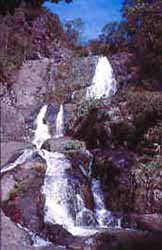


 General Information
General InformationThe Park, located on the southern peninsular of Thailand in Nakhon Sri Thammarat province is Khao Luang National Park. It is named after the tallest mountain in the park w
 hich is also the tallest in southern Thailand. The park is mountainous with many tall mountains along this range.
hich is also the tallest in southern Thailand. The park is mountainous with many tall mountains along this range.Geography
The Park covers an area of 570km encompassing a huge variety of
 wildlife, including mountains, forests, rivers and waterfalls. Providing a place of beauty for visitors to come and experience. This area also provides an important watershed area for the surrounding villages and farms. Park provides a green roof to southern Thailand
wildlife, including mountains, forests, rivers and waterfalls. Providing a place of beauty for visitors to come and experience. This area also provides an important watershed area for the surrounding villages and farms. Park provides a green roof to southern Thailand and its quality earned it an award in 1999 for being a place of outstanding beauty and nature. Park was officially designated a National Park on the 18th December 1974, becoming the 9th National Park in Thailand. The Headquarters of the Park is 30km from the town of Nakhon Sri Thammarat. mountainous Park is a watershed for the Tapee River. It is located within several districts; Lansaka, Chawang, Phiboon, Plomkiri, Chang Klang and Nop Pi Dam.
and its quality earned it an award in 1999 for being a place of outstanding beauty and nature. Park was officially designated a National Park on the 18th December 1974, becoming the 9th National Park in Thailand. The Headquarters of the Park is 30km from the town of Nakhon Sri Thammarat. mountainous Park is a watershed for the Tapee River. It is located within several districts; Lansaka, Chawang, Phiboon, Plomkiri, Chang Klang and Nop Pi Dam.Climate
Due to the Parks location on the peninsular, it receives monsoons from both the east and the west coasts and means that the Park receives a great deal of rain all year and also cold weather.
 There are two main seasons. Rainy season from May through to January with the heaviest of the rainfall between October and December. Hot season is between February and April. Over the year the Park receives approximately 3,500-4,000mm. of rainfall. The highest temperatures range between 28-30 Celcius and the lowest between 15-17 Celcius in January and February.
There are two main seasons. Rainy season from May through to January with the heaviest of the rainfall between October and December. Hot season is between February and April. Over the year the Park receives approximately 3,500-4,000mm. of rainfall. The highest temperatures range between 28-30 Celcius and the lowest between 15-17 Celcius in January and February.Flora and Fauna
Moist Evergreen Forest, which can be found in the valleys and in damp gulleys and riversides.
 Hill Evergreen Forest and Lower Montane Forest,Over 300 species of orchids can be seen within the Park. Khao Luang is the only place in the world where some of these can be found.
Hill Evergreen Forest and Lower Montane Forest,Over 300 species of orchids can be seen within the Park. Khao Luang is the only place in the world where some of these can be found.  There are no less than 327 species of animals living in Khao Luang, some of these include; Malayan Tapir (only seen if you are very lucky), Sumatran Serow, Pigtailed Macaque, Bush-tailed Porcupine, Clouded Leopard, Barking deer, Sambardeer, Binturong, Panther, Tiger, Wild Pig, Banded Languar and Dusky Speckled Languar. Bird species include, Black Eagle, Red Jungle Fowl, Great Argus Pheasent, Crested Fireback Pheasent, White-crowned Hornbill, Bushy-crested Hornbill, Great Pied Hornbill, Helmeted Hornbill, Redcrowned Barbet and Sunbirds.
There are no less than 327 species of animals living in Khao Luang, some of these include; Malayan Tapir (only seen if you are very lucky), Sumatran Serow, Pigtailed Macaque, Bush-tailed Porcupine, Clouded Leopard, Barking deer, Sambardeer, Binturong, Panther, Tiger, Wild Pig, Banded Languar and Dusky Speckled Languar. Bird species include, Black Eagle, Red Jungle Fowl, Great Argus Pheasent, Crested Fireback Pheasent, White-crowned Hornbill, Bushy-crested Hornbill, Great Pied Hornbill, Helmeted Hornbill, Redcrowned Barbet and Sunbirds. 






 These deposits can be clearly seen forming the cliffs surrounding Makha Bay.
These deposits can be clearly seen forming the cliffs surrounding Makha Bay. 































